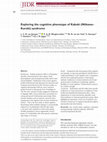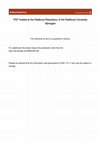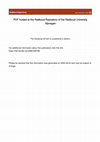Papers by William van der Veld

Probably the most ignored assumption in the social and behavioral sciences is the assumption that... more Probably the most ignored assumption in the social and behavioral sciences is the assumption that measures are observed without error. Ignoring measurement error when it is present will result in conclusions that are biased to some degree. A second commonly ignored assumption is that survey measures can be used to make valid comparisons between (groups of) persons. When the unit of the scale on which we express ourselves is widely used, for example, time in minutes, between-person comparisons are most likely valid. When time is, however, expressed in subjective labels, for example, very long, long, not so long, short, it is less clear whether between-person comparisons are valid; what a short time is for one person might be not so long for another. Saris (1988) showed for different topics that people vary in using these scales. For measures to be meaningfully comparable between (groups of) persons, they should be equivalent (Meredith, 1993). Measurement equivalence is tested with measurement invariance tests. The standard procedure tests between-group constraints on the factor model using multiple group structural equation modeling (SEM) analysis (Meredith, 1993). Recently, alternatives have been developed using Bayesian approaches (Cieciuch, Davidov, Schmidt, Algesheimer, & Schwartz, 2014; Asparouhov & Muthen, 2010). However, our approach is different and has two unique aspects. 1 First, we use a different measurement model - implementing the concept of correction for measurement error in invariance testing. Second, we use a different approach to evaluate invariance across groups. This new approach to model evaluation is an answer to two issues that make testing multigroup 246SEM models complex. The first issue is the power of the test, which is influenced by sample size, normality of the data, and the size of incidental model parameters (Saris, Satorra, & van der Veld, 2009). These conditions are often found in measurement invariance testing. The second issue is the large amount of output that SEM programs produce in case of multigroup analysis, which makes it hard to oversee the results.
Journal of Obsessive-Compulsive and Related Disorders, Oct 1, 2022

Journal of Intellectual Disability Research, Feb 6, 2019
Background Kabuki syndrome (KS) is a Mendelian disorder, characterised by short stature, facial d... more Background Kabuki syndrome (KS) is a Mendelian disorder, characterised by short stature, facial dysmorphisms and developmental delay and/or intellectual disability. Clarification of the neurocognitive profile in KS may provide directions for education and treatment interventions for KS. Previous studies on cognitive functioning in KS are scarce and have mainly focused on the general level of intelligence. The few more extensive studies suggested weaknesses in language skills, visuoconstruction, perceptual reasoning and speed of information processing. Other relevant domains such as memory, executive functioning and social cognition have not been studied yet. Method This is the first study in which cognitive functioning within multiple domains is systematically explored in 29 participants with KS (age range: 5-48 years) and compared to both norm groups (healthy population) and an appropriate control group of 15 individuals with other genetic syndromes (age range: 6-28 years). Results Compared to the norm groups of the cognitive test manuals, as expected, participants with KS show a weaker performance on all cognitive tests. Comparison with the more appropriate genetic control group indicates weaknesses in visuoconstruction and visual memory and no weaknesses in planning, cognitive flexibility or social cognition. Verbal memory seems to be a relative strength. Conclusions Individuals with KS suffer from specific weaknesses in visuoconstruction, in addition to their intellectual disability/developmental delay. These impairments in visuoconstruction plausibly result from problems in visual perceptual processing, which highlight the importance of the use of auditory cues instead of visual cues in targeted educational support and psychosocial interventions.

European Early Childhood Education Research Journal, Feb 22, 2016
Early detection of reading problems is important to prevent an enduring lag in reading skills. We... more Early detection of reading problems is important to prevent an enduring lag in reading skills. We studied the relationship between speed of word recognition (after six months of grade 1 education) and four kindergarten pre-literacy skills: letter knowledge, phonological awareness and naming speed for both digits and letters. Our sample consisted of 178 pupils divided over seven classes. In agreement with the literature, we found that all four kindergarten tests were related to speed of word recognition in grade 1. We also performed a multiple regression analysis with a set of background variables and the four kindergarten tests. The model explained 53% of the variance in speed of word recognition. However, only letter knowledge and naming speed for digits had a significant direct effect. Our conclusion is, nevertheless, that all four kindergarten tests should be used to identify children at risk for reading problems.

BMC Psychology, Feb 10, 2016
Background: In recent years, it has been increasingly recognized that the absence of mental disor... more Background: In recent years, it has been increasingly recognized that the absence of mental disorder is not the same as the presence of positive mental health (PMH). With the PMH-scale we propose a short, unidimensional scale for the assessment of positive mental health. The scale consists of 9 Likert-type items. Methods: The psychometric properties of the PMH-scale were tested in a series of six studies using samples from student (n = 5406), patient (n = 1547) and general (n = 3204) populations. Factorial structure and measurement equivalence were tested with the measurement invariance testing. The factor models were analysed with the maximum likelihood procedure. Internal consistency was examined using Cronbach's alpha, test-retest reliability, convergent and divergent validity was examined by Pearson correlation. Sensitivity to (therapeutic) change was examined with the t-test. Results: Results confirmed unidimensionality, scalar invariance across samples and over time, high internal consistency, good retest-reliability, good convergent and discriminant validity as well as sensitivity to therapeutic change. Conclusions: These findings suggest that the PMH-Scale indeed measures a single concept and allows us to compare scores over groups and over time. The PMH-scale thus is a brief and easy to interpret instrument for measuring PMH across a large variety of relevant groups.

European Journal of Psychological Assessment, 2020
. The Dimensional Obsessive-Compulsive Scale (DOCS) is a self-report questionnaire aimed to measu... more . The Dimensional Obsessive-Compulsive Scale (DOCS) is a self-report questionnaire aimed to measure the severity of obsessive-compulsive symptoms on four thematically different symptom dimensions (contamination, responsibility for harm, unacceptable thoughts, and symmetry and completeness). The DOCS was developed in the US in response to the insufficiency of existing OCD measures. The 20-item scale is used in research and clinical settings. We translated the DOCS into Dutch and examined the psychometric properties in a clinical sample. In addition, we further examined the US version of DOCS with respect to measurement invariance between patient and non-patients and also between the US and the Dutch version of the DOCS. The analyses showed that the Dutch version is a valid and reliable version of the DOCS. Measurement invariance tests indicated that patient scores can be validly compared with non-patient scores. Therefore, the DOCS is a good instrument to monitor the development of OCD, for example, during treatment. The same result was found for the US DOCS and the Dutch DOCS, hence US scores and Dutch scores can be validly compared. With these two studies we have extended our knowledge of the DOCS, beyond the common psychometric properties.
International Journal of Behavioral Medicine, 2016
Om kinderen zo goed mogelijk tijdens hun leesontwikkeling te begeleiden, is het niet alleen belan... more Om kinderen zo goed mogelijk tijdens hun leesontwikkeling te begeleiden, is het niet alleen belangrijk om ze al in groep 1-2 voor te bereiden op het leesonderwijs, maar ook om tijdig leesproblemen te signaleren. De auteurs van dit artikel raden aan om dit al in de kleutergroep te doen. De mogelijkheden zijn er. Door enerzijds te observeren en anderzijds gestandaardiseerde toetsen (letterkennis en benoemsnelheid van cijfers), af te nemen, krijgt de leerkracht zicht op de leerlingen die in groep 3 leesproblemen zouden kunnen krijgen. Te vaak worden ‘risicolezers’ pas na de herfstsignalering (in oktober van groep 3) gesignaleerd. Dat kan te laat zijn en kan ten koste gaan van de leesontwikkeling en -motivatie van deze kinderen. Een kind krijgt immers geen tweede kans om op jonge leeftijd goed te leren lezen.

Genes, Brain and Behavior, 2019
KBG syndrome is a neurodevelopmental disorder, caused by dominant mutations in ANKRD11, that is c... more KBG syndrome is a neurodevelopmental disorder, caused by dominant mutations in ANKRD11, that is characterized by developmental delay/intellectual disability, mild craniofacial dysmorphisms, and short stature. Behavior and cognition have hardly been studied, but anecdotal evidence suggests higher frequencies of ADHD‐symptoms and social‐emotional impairments. In this study, the behavioral and cognitive profile of KBG syndrome will be investigated in order to examine if and how cognitive deficits contribute to behavioral difficulties. A total of 18 patients with KBG syndrome and a control group consisting of 17 patients with other genetic disorders with comparable intelligence levels, completed neuropsychological assessment. Age‐appropriate tasks were selected, covering overall intelligence, attention, memory, executive functioning, social cognition and visuoconstruction. Results were compared using Cohen's d effect sizes. As to behavior, fewer difficulties in social functioning an...

Psychology in the Schools, 2021
In 2009, School-Wide Positive Behavioral Interventions and Supports (SWPBIS) was introduced in th... more In 2009, School-Wide Positive Behavioral Interventions and Supports (SWPBIS) was introduced in the Netherlands to support schools in creating safe learning environments. In this longitudinal study, we explored effects of SWPBIS on student outcomes in the Netherlands. Fidelity of implementation of SWPBIS has been associated with improved student outcomes. The purpose of this study was to examine the relation between changes in fidelity and student outcomes. A total of 66 elementary schools (n = 14,256 students) were followed for 3 years (2015-2018). We collected yearly data on fidelity, social safety (consisting of students' social well-being, general feeling of safety, harassment, prevalence of unsafe locations in and around schools), behavior incidents, and additional behavioral support. Using repeated measures analysis of variances, we saw an increase in fidelity scores and a decline in the percentage of students stating there were unsafe locations in and around school. Multiple regression analyses showed that changes in fidelity were related to changes in both students' social well-being and the number of behavior incidents. Limitations were discussed, such as the absence of comparison











Uploads
Papers by William van der Veld